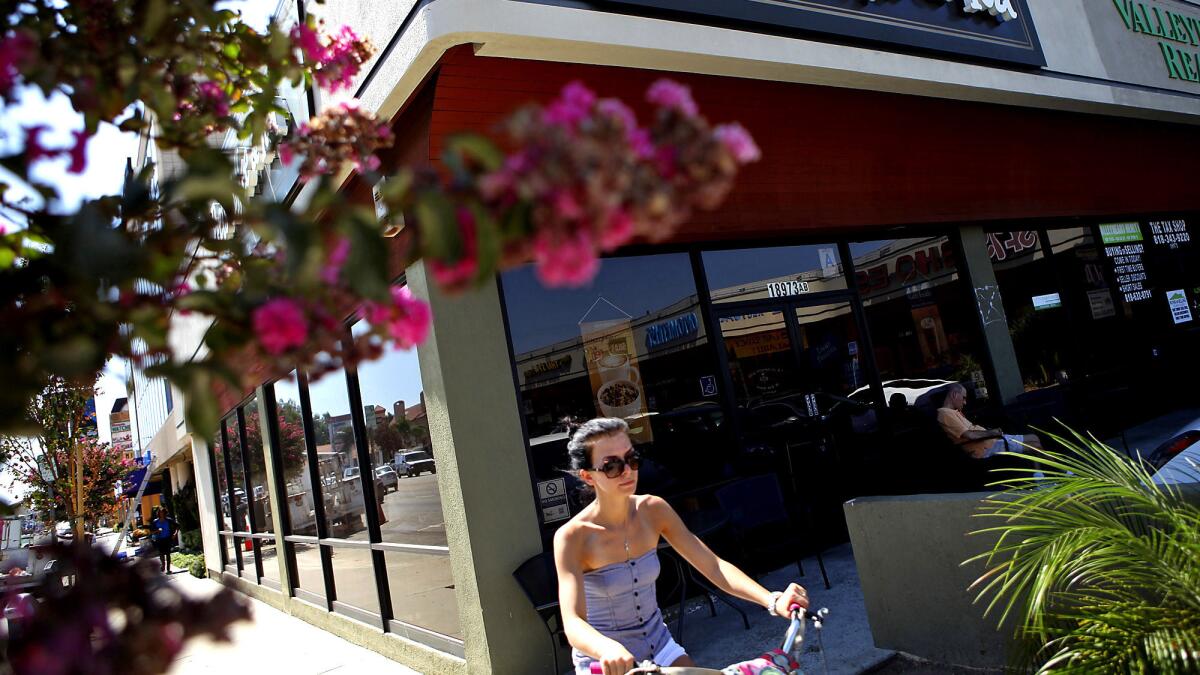Neighborhood Spotlight: Tarzana swings a lot less than its namesake

It bears the name of the world’s most famous ape-raised yodeler and jungle adventurer, but unlike its vine-swinging namesake, Tarzana is a place with its feet planted firmly on manicured lawns.
The district has a rustic origin story: The hills that would someday boast two country clubs and some of of the most expensive homes in the west San Fernando Valley were originally part of the Rancho El Encino, a land given over to cattle herds and citrus trees through which the dusty Camino Real meandered on its way to Santa Barbara.
The coming of the L.A. aqueduct unleashed land speculators on the Valley, and the ranch that would form the nucleus of Tarzana became one of the vast tracts of real estate snapped up by Los Angeles Times publisher Harrison Gray Otis.
In 1917, Edgar Rice Burroughs — novelist and father of pulpy favorites like Tarzan, the Barsoomians of Mars, and the dinosaurs of “The Land that Time Forgot” — purchased the land and gave it the name of his most famous literary creation.
A decade later, the locals, sensing a real estate marketing opportunity as only Angelenos can, decided to adopt the name Tarzana for the little town that had sprung up at the corner of Ventura and Reseda boulevards.
Scattered subdivisions soon began to dot the hills and plains, including Melody Acres, a semirural development that still allows residents to keep livestock, deep within one of the world’s most urbanized valleys.
The end of World War II saw an increased pace of development, and by the time the freeways opened in the 1960s, Tarzana’s once-rural landscape was part of a massive suburb that stretched uninterrupted from Burbank to Canoga Park.
Yet the pace of life is noticeably more relaxed than in closer-in parts of the Valley. There is golf to be played, including at El Caballero Country Club, one of the first country clubs in L.A. to accept both Jews and Christians as members. The local business improvement district has made strides in re-establishing a walkable shopping village along Ventura Boulevard.
It might not be as flashy and luridly exciting as the books that gave it its name, but, as a 1920s real estate pamphlet put it, Tarzana has “less fog, less dampness, less rheumatism, less neuritis and a longer life.” Hard to argue with that.
Neighborhood highlights

36 holes of hilltop golf: Tarzana’s two country clubs — one of which sits on a portion of Burroughs’ old estate — offer plenty of tee time opportunities.
Suburban farming: Tarzana’s Melody Acres is zoned R-A, which means you can finally start your free-range chicken farm while still only being five minutes away in any direction from a Starbucks.
Neighborhood challenges
May be too relaxed for some: Tarzana is great for people who find Encino too exciting.
Expert insight
Historically, south of Ventura Boulevard was always the most coveted and affluent part of the neighborhood, said Jason Insalaco, a real estate broker at Kelton Properties. But that’s starting to change.
“In my experience lately, the northern part of Tarzana — which would be north of the 101 — has become much more desirable because of the price point,” he said. Home buyers are able to find “a home with a pool on a nice-sized lot for less than $750,000.”
Because of that, he said, “prices are going up quickly.” In May, his client closed on a home that had seven offers over asking price.
Market snapshot
Portions of the 91335 and the 91356 ZIP Codes overlap the Tarzana area. In May, based on 38 sales, the median price for single-family homes in the 91335 ZIP was $481,000. The median price in the 91356 ZIP was $1.023 million based on 27 sales.
Report card
Within the boundaries of Tarzana is Wilbur Avenue Elementary, which scored 914 out of 1,000 in the 2013 Academic Performance Index. Sherman Oaks Center of Enriched Studies scored 891; Nestle Avenue Elementary scored 886; and Gaspar De Portola Middle had a score of 866. Vanalden Avenue Elementary and Tarzana Elementary scored 850 and 794, respectively.
Sign up for Essential California
The most important California stories and recommendations in your inbox every morning.
You may occasionally receive promotional content from the Los Angeles Times.



